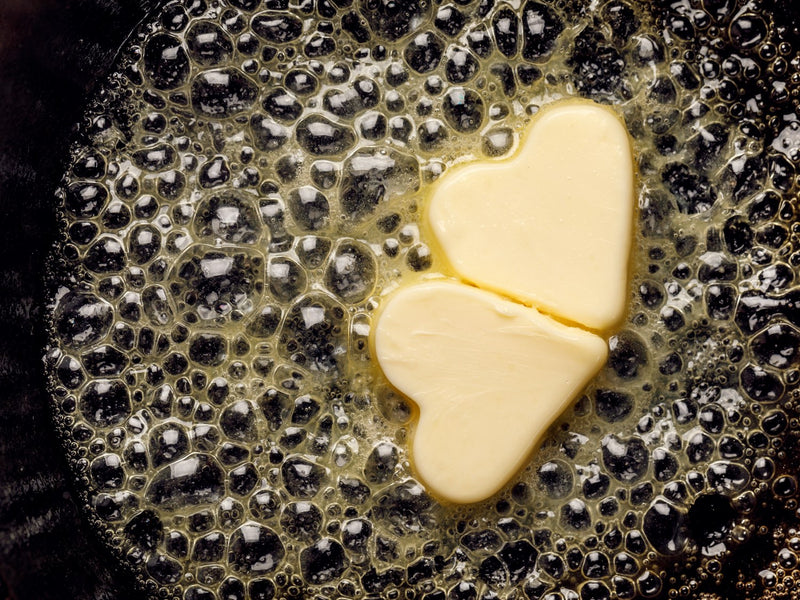
It may seem like a simple fridge staple on the surface, but the makeup of butter (in particular, the percentage of butterfat in that butter) plays a big role in flavor, texture, and quality.
In turn, all of these factors can influence the outcome of your chocolate chip cookies, pancakes, and even your scrambled eggs, so it's important to know what butterfat is, why it matters, and which percentage of butterfat is right for your cooking needs.
What is butterfat?
Butterfat is the fat found in cream. Contrary to what you might think, the butter you purchase at the grocery store isn't simply "butterfat," but rather a combination of some percentage of butterfat and other components. The minimum butterfat content found in American butters is 80%. Products with butterfat below 80% cannot be labeled "butter," and are often called spreads instead. Along with 80% butterfat, the average butter sold in the United States contains about 16-18% water and 2-4% additional components, such as milk solids and sometimes salt. Salted butter typically contains 1-2% salt by weight, or about a 1/4 teaspoon of salt per stick.
Butterfat composition and types of butter
Not all butter is created equal! If you've spent much time in the butter aisle, you may have wondered why certain butters have a higher butterfat content than others. The most common types of butter found in a typical American grocery store are American butter and European-style butter, both of which have distinct butterfat compositions.
American butter
American butter (sometimes called "sweet cream butter" or simply "salted butter") typically contains the minimum 80% butterfat. American butter can be sold salted or unsalted, and is widely available throughout the country.
European-style butter
The minimum butterfat content for "European-style" butter sold in the United States is 82%, and these butters can range from 82-86% butterfat. For those in European countries, 82% is the minimum for all butter sold in stores. Though 2 percentage points may not seem like much on paper, the slightly higher butterfat content of these butters makes a big difference in quality, flavor, and texture when compared to American butter.
Nellie's Free Range Butter
So where does Nellie's Free Range Butter fit in? Both our salted and unsalted butters are 84% butterfat, and you can taste (and see!) the difference. Our high butterfat content means less water filler, yielding a richer flavor and a softer, creamier texture than your average butter from the grocery store.
Why does butterfat matter?
Butterfat is arguably the most important factor when it comes to the flavor, texture, quality, and even nutritional content of any given butter. In general, a higher butterfat content means a better butter.
Flavor
You've probably heard the saying "fat is flavor," and there's a lot of truth to it. Butters with 82% or higher butterfat tend to have a much richer and fuller flavor than their lower butterfat counterparts.
Texture
Butters with 82% or higher butterfat content have a softer, smoother, melt-in-your-mouth texture without feeling greasy. They cut clean when sliced, whereas lower butterfat butters often crumble or end up with jagged edges when cut into. Like all animal fat, butterfat is solid at room temperature, so butters with a higher butterfat content hold their shape well while remaining smooth and spreadable when left on the counter. Butters that sag and droop at room temperature tend to be closer to 80% butterfat.
Quality
Butterfat gives butter its color, and the percentage of butterfat can help determine whether that butter is pale and off-white or a rich yellow color. The color of butterfat itself is determined by the cow's diet; a grass-fed diet rich in plants and greens from the pasture yields a yellower butter.
Nutritional content
Butter is primarily made up of fat, but also contains numerous nutrients that are essential for health, including vitamins A and E, riboflavin, niacin, calcium, and phosphorus. Vitamins A and E, which are both fat soluble, are found in high proportions in butterfat itself, so the higher the butterfat, the more concentrated the nutrients. This means that butter like ours contains just a little more of the good stuff and less water filler.
Is a higher butterfat healthy?
Butterfat is made up of approximately 63% saturated fat, 26% monounsaturated fat, and 4% polyunsaturated fat. The current Dietary Guidelines for Americans recommend limiting saturated fat intake to less than 10% of your daily calories, so even butters with a higher butterfat can be enjoyed in moderation alongside other healthy fats from foods like eggs, nuts, olive oil, and fish.
What type of butter is best for baking?
At 84% butterfat, our butter is incredibly versatile. It will shine in recipes that showcase its flavor (think buttered toast and butter-basted steaks), and is also ideal for finishing anything from simple side dishes to pasta; adding a pat to steamed veggies or noodles just before serving is always a good idea! As for baking, the flavor and quality of our higher butterfat butter will show in your cookies and cakes. While you may not taste a difference in treats that feature strong flavors like spices, coffee, and berry jams, the difference in quality will be unmistakable in simple and elegant recipes like classic butter cookies or your favorite buttercream frosting. Here are some of our favorite ways to showcase Nellie's Free Range Butter:
- Cookies
- Pound cake
- Buttercream frosting
- Pie crust and other laminated doughs









